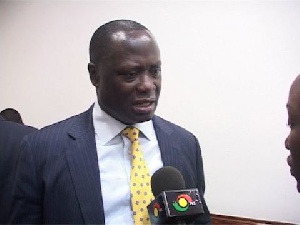Mr. Emmanuel Armah-Kofi Buah, the Minister of Energy and Petroleum, has said Ghana would relentlessly grow its oil reserves in order to ramp up and sustain oil and gas production.
Speaking at the Ministry’s turn at the Meet the Press forum in Accra, he said in order to build an industry; there was the need to have a large reserve since “one oil field does not create an industry.”
He noted that the upstream oil and gas sector was gradually becoming a dominant and critical segment of the Ghanaian economy, becoming the second largest sector after mining, to contribute significantly to the national Gross Domestic Product and government revenues.
“Crude exports for instance have assumed a significant proportion of total exports, rising from 2.17 percent in 2011 to 28.7 percent in 2014, while petroleum revenue as a share of overall revenue surged from 5.4 percent in 2011 to 13.1percent in 2014” he stated.
According to the Minister, the second FPSO, the J.E.A Mills, designed in Singapore for the pooled production of the Tweneboa, Enyera, Ntomme (TEN) fields, would put Ghana firmly in the league of oil producing nations.
The TEN fields are expected to produce about 70,000 barrels of oil per day (bopd) and 50 million standard cubic feet (mmscf) of gas per day.
The FPSO Mills is expected to arrive in Ghana in March 2016, while First Oil is expected to be delivered in August 2016, and First Gas by the third quarter of 2017.
This would add to the Jubilee field, which has up to September 2015, produced a total of 152 million barrels of oil and 39 billion cubic feet of gas.
In 2015, production improved over 2014 with a year-to-date average daily production of 101,350 bopd and 100mm scfd.
Mr. Buah said Tullow Ghana, operators of the Jubilee field, and Kosmos, operators of the Greater Jubilee and Mahogany Teak (MTA) field, and the Ghana National Petroleum Corporation, its local partner, were collaborating to integrate the nearby MTA discoveries into the West Cape Three Points Block with the jubilee under the Greater Jubilee Full Field Development.
“A joint Front End Engineering Design (FEED) is being carried out to determine facilities needed for this integration and both contractors have until the close of the year to submit the Greater Jubilee Full Field Development Plan,” he stated.
“Also, the Sankofa Gye Nyame Project, which has been endorsed by the World Bank and the International Finance Corporation (IFC), has been negotiated and concluded, with a total investment of seven billion dollars ($7billion).”
The project, he noted, is the biggest gas investment in the West African sub-region recently.
As part of this project and following the approval of the Plan of Development (POD), a third FPSO is currently under construction for the project, which is currently expected to produce about 45,000 bop by 2017 and 170 MMScfd of Gas by 2018.
The Ministry, Mr Buah said, had also approved the work programme for work to start on the Voltaian Basin, including the acquisition of 2000kn of 2D seismic data and the drilling of two wells in order to unearth the potential of the vast inland basin.
Mr. Alex Mould, Chief Executive Officer of the Ghana National Petroleum Corporation, explained, however, that the actual drilling of oil from the Voltaian Basin could take years as feasibility studies and seismic studies would take about two to three years.
He said the studies were needed in order to determine whether or not there was petroleum system in the Basin before investors could be attracted to develop it, if a system is found.
Business News of Saturday, 17 October 2015
Source: GNA

















